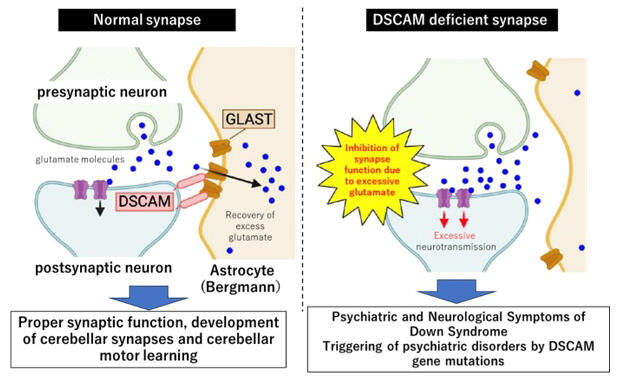A research group led by Director Mikio Hoshino and Dr. Ken-ichi Dewa (currently part of the RIKEN Center for Brain Science) of the Department of Biochemistry and Cellular Biology, National Institute of Neuroscience at the National Center of Neurology and Psychiatry (NCNP), and Associate Professor Nariko Arimura from the Department of Pharmacology, Graduate School of Pharmaceutical Sciences at Tohoku University demonstrated that Down syndrome cell adhesion molecule (DSCAM), a Down syndrome-related gene product, is involved in healthy synapse function and neuron development as well as cerebellar motor learning through clearance of excess glutamate in synapses. According to Hoshino, "In our study, administration of riluzole (a medication for amyotrophic lateral sclerosis [ALS]) improved the cerebellar learning function in mice deficient in DSCAM. Controlling glutamate transporters may lead to treatments of neuropsychiatric disorders." The study was published in Nature Communications.

Created using BioRender and adapted from NCNP press release.
In synaptic transmission in brain neural circuits, the neurotransmitter glutamate is released into the synaptic cleft to convey information. Excess glutamate other than that needed to convey information is cleared promptly by surrounding cells. Excess glutamate that is not cleared may impair synapse function and cause epilepsy or psychiatric or developmental disorders.
Before the current study, the molecular mechanism through which glutamate transporters (responsible for glutamate clearance) accumulate in synapses and clear excess glutamate efficiently was unknown.
The results of experiments by the researcher revealed that DSCAM is expressed in neurons in the cerebellum and is localized especially in synapses made by Purkinje cells. Subsequently, the research group found that Dscam-knockout mice showed impaired glutamate clearance in synapses made by Purkinje cells (parallel fiber synapses). Glutamate-aspartate transporter (GLAST) molecules on the membrane of Bergmann glia (a type of astrocyte) play a role in removing excess glutamate in these synapses. The Dscam-knockout mice showed impaired accumulation of GLAST in the synapses.
Detailed analyses revealed that DSCAM proteins on the Purkinje cell membrane bind via their extracellular domain to GLAST on the Bergmann glia cell membrane, and then attract GLAST to accumulate on the synaptic side. When DSCAM is deficient, GLAST on the Bergmann glia cannot accumulate near the synapses. Thus, excess glutamate cannot be cleared efficiently. As a result, leaked glutamine leads to not only the loss of normal synapse function but also the impairment of synapse development and motor learning in the cerebellum.
Moreover, the research group found that the administration of riluzole, a glutamate transporter enhancer, improved synapse development in the cerebellum.
The research group will further examine whether the cerebral cortex has the same function as that of the cerebellum. In addition, the research group will clarify neuropsychiatric symptoms in Down syndrome and the pathological mechanisms of psychiatric disorders related to DSCAM gene mutations.
Journal Information
Publication: Nature Communications
Title: Neuronal DSCAM regulates the peri-synaptic localization of GLAST in Bergmann glia for functional synapse formation
DOI: 10.1038/s41467-023-44579-z
This article has been translated by JST with permission from The Science News Ltd. (https://sci-news.co.jp/). Unauthorized reproduction of the article and photographs is prohibited.




